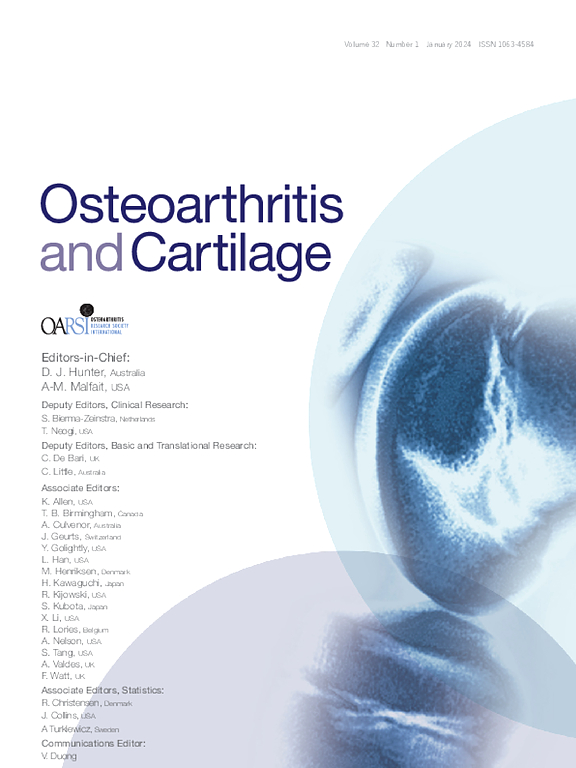骨关节炎大鼠模型中整体软骨表面损伤的评估:利用微计算机断层扫描的软骨粗糙度评分(CRS)。
IF 7.2
2区 医学
Q1 ORTHOPEDICS
引用次数: 0
摘要
研究目的本研究旨在为临床前骨关节炎(OA)研究建立一种准确、可靠的成像生物标志物,重点是早期检测软骨表面退化:本研究使用50只雄性Wistar大鼠,通过微计算机X射线断层成像(µCT)、组织病理学分析和步态分析,观察胶原酶诱导的骨关节炎(CIOA)的进展。研究人员开发了一种新参数--软骨粗糙度评分(CRS),用于根据μCT数据评估软骨结构损伤,并与组织病理学OARSI软骨退化评分(OARSI CDS)进行了比较。此外,由于CRS映射的是整个表面,因此可用于模拟组织学取样的不确定性水平:结果:CRS 和 OARSI CDS 呈线性关系。健康软骨的 CRS 为 2.75(95% CI:1.14-4.36),OARSI 每增加 1 个单位,CRS 预计增加 0.64(95% CI:0.35-0.92)。在组织病理学评分和 CRS 中,CIOA 导致的软骨退化都很明显。然而,只有 CRS 的灵敏度足以显示从第 10 天到第 60 天的持续损伤进展。此外,我们对组织学取样的模拟显示,要以切片的方式准确反映软骨表面退化的全部程度,需要多达16张间距为200微米的冠状切片。步态分析显示,只有在注射胶原酶后八天,步态才会发生变化,到第60天步态趋于正常:CRS分析方法是评估软骨表面损伤的有力工具。这项研究表明,在评估软骨表面损伤时,自动三维分析比传统的二维组织学方法更有潜力:微计算机断层扫描数据可通过ida.fairdata.fi46 (https://doi.org/10.23729/f33d3ba8-01b8-47af-90dd-94b7c7861247)获取。本文章由计算机程序翻译,如有差异,请以英文原文为准。
Assessment of whole cartilage surface damage in an osteoarthritis rat model: The Cartilage Roughness Score (CRS) utilizing microcomputed tomography
Objective
This study aims to establish an accurate and robust imaging biomarker for pre-clinical osteoarthritis (OA) research, focusing on early detection of cartilage surface degeneration.
Method
Using 50 male Wistar rats, this study aims to observe Collagenase-induced OA (CIOA) progression through microcomputed x-ray tomography (µCT), histopathological analysis, and gait analysis. A novel parameter, Cartilage Roughness Score (CRS), was developed for assessing cartilage structural damage from µCT data and was compared with histological OARSI Cartilage Degeneration Score (OARSI CDS). Additionally, as CRS maps the full surface, it was used to simulate the level of uncertainty in histological sampling.
Results
CRS and OARSI CDS have a linear relationship. CRS for healthy cartilage is 2.75 (95% CI: 1.14–4.36), and with every 1 unit increase in OARSI, CRS is expected to increase by 0.64 (95% CI: 0.35–0.92). Cartilage degeneration due to CIOA was evident in both histopathological scoring and CRS. However, only CRS was sensitive enough to show consistent damage progression from day 10 to day 60. Furthermore, our simulation for histological sampling suggested that up to 16 coronal slices with 200 µm spacing would be needed to accurately represent the full extent of cartilage surface degeneration in a slice-wise manner. Gait analysis showed changes solely at eight days post-collagenase injection, normalizing by day 60.
Conclusion
The CRS analysis method emerges as a robust tool for cartilage surface damage assessment. This study demonstrates the potential of automatic 3D analysis over the traditional 2D histological approach when evaluating cartilage surface damage.
求助全文
通过发布文献求助,成功后即可免费获取论文全文。
去求助
来源期刊

Osteoarthritis and Cartilage
医学-风湿病学
CiteScore
11.70
自引率
7.10%
发文量
802
审稿时长
52 days
期刊介绍:
Osteoarthritis and Cartilage is the official journal of the Osteoarthritis Research Society International.
It is an international, multidisciplinary journal that disseminates information for the many kinds of specialists and practitioners concerned with osteoarthritis.
 求助内容:
求助内容: 应助结果提醒方式:
应助结果提醒方式:


